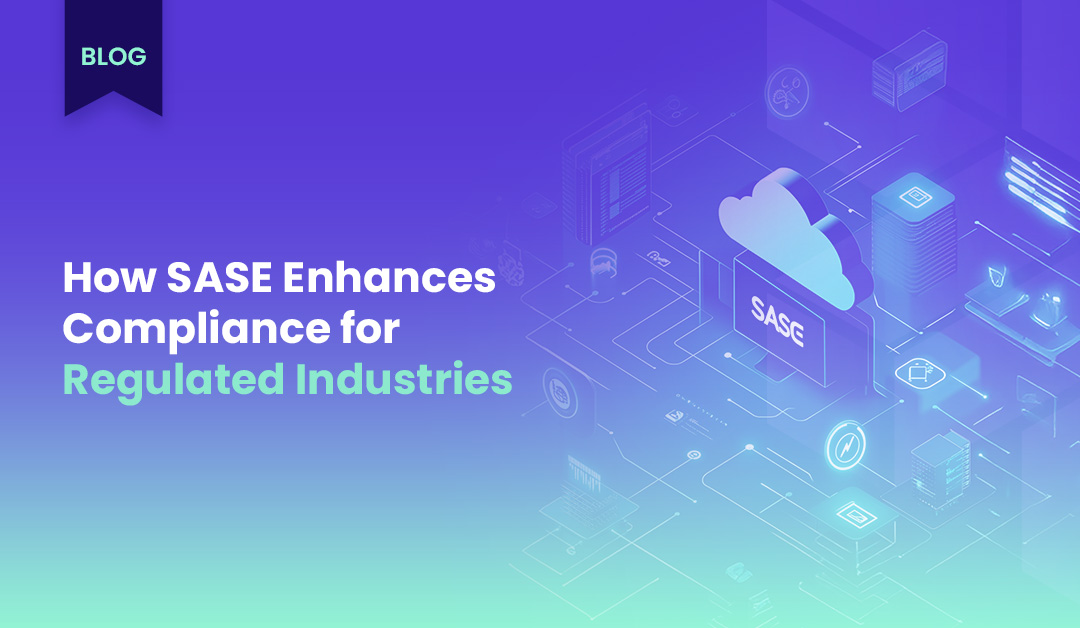How SASE Enhances Compliance for Regulated Industries
In today's digital landscape, organizations face pressure to safeguard data while adhering to complex regulations. Traditional security approaches fall short in addressing challenges posed by distributed networks and cloud-based applications. Secure Access Service Edge (SASE) combines network security functions with wide-area networking capabilities to provide a comprehensive solution.
Author
Date
Category
All Categories
- AI-powered security
- Attacks & Threats
- Cybersecurity
- Hybrid Cloud
- Network
- Network Firewall
- Network Protection
- News
- Remote Workforce
- Security
- Zero Trust
Contents
Popular Posts
Product
Join the Newsletter

In today’s digital landscape, organizations face pressure to safeguard data while adhering to complex regulations. Traditional security approaches fall short in addressing challenges posed by distributed networks and cloud-based applications. Secure Access Service Edge (SASE) combines network security functions with wide-area networking capabilities to provide a comprehensive solution.
This article explores how SASE empowers regulated industries to enhance compliance, streamline security operations, and mitigate risks. We’ll delve into the benefits of SASE for regulated sectors, its implementation across industries, and best practices for leveraging this approach to meet compliance objectives.
The Compliance Challenge for Regulated Industries
It’s common that regulated industries face challenges in meeting data protection and privacy regulations. Modern IT systems, cloud services, and remote work have increased the likelihood of security breaches and compliance violations. Healthcare providers and financial institutions must navigate regulatory frameworks like HIPAA, GDPR, PCI DSS, and NIST. These regulations require strong security measures and detailed data records. The traditional security model of firewalls and VPNs is insufficient in today’s distributed and cloud-focused environment. As employees access sensitive data from different locations and devices, the risk of attacks increases, making it harder for IT teams to monitor and control data flows. Organizations need to be agile and adaptable in their approach to security and compliance, responding quickly to new regulations and emerging security risks without sacrificing efficiency or user experience. The adoption of SASE is a game-changing strategy for regulated industries to overcome these challenges and achieve compliance maturity.
The Role of SASE in Regulatory Compliance
SASE represents a paradigm shift in how organizations approach network security and compliance. By converging networking and security functions into a cloud-delivered service, SASE provides a unified and scalable framework that aligns perfectly with the needs of regulated industries.
At its core, SASE combines software-defined networking capabilities with a suite of security services, including:
This integrated approach enables organizations to implement consistent security policies across their entire network infrastructure, regardless of where users, applications, or data reside. By centralizing policy management and enforcement, SASE simplifies compliance efforts and reduces the risk of configuration errors or policy inconsistencies that could lead to regulatory violations.
How SASE Supports Compliance Across Industries
The flexibility of SASE makes it a great solution for many industries that have strict regulations. Let’s see how SASE can help with compliance challenges in different sectors:
Healthcare: Ensuring HIPAA and HITECH Compliance
Healthcare organizations face unique challenges in protecting patient data while ensuring seamless access to critical information for care providers. SASE offers several key benefits for healthcare compliance:
- Data encryption: SASE provides end-to-end encryption for all data in transit, helping healthcare providers meet HIPAA requirements for safeguarding protected health information (PHI).
- Access control: Zero Trust Network Access (ZTNA) capabilities enable granular access controls based on user identity, device posture, and context, ensuring that only authorized personnel can access sensitive patient data.
- Audit trails: SASE solutions offer comprehensive logging and reporting features, facilitating the creation of detailed audit trails required for HIPAA compliance and breach investigations.
- Telehealth security: As telehealth services become increasingly prevalent, SASE can secure remote consultations and protect patient data accessed from various locations and devices.
Financial Services: Meeting GDPR and PCI DSS Requirements
Financial institutions must comply with a complex web of regulations governing data protection and privacy. SASE can help address these challenges:
- Data localization: SASE’s distributed architecture allows financial firms to enforce data residency requirements by routing traffic through specific geographic locations, ensuring compliance with GDPR and other regional privacy laws.
- Secure transactions: By integrating advanced threat protection and DLP capabilities, SASE can safeguard financial transactions and prevent unauthorized access to sensitive customer information.
- Multi-factor authentication: SASE solutions typically include robust authentication mechanisms, helping financial institutions meet PCI DSS requirements for strong access controls.
- Continuous monitoring: Real-time threat intelligence and behavioral analytics enable financial firms to detect and respond to potential security incidents promptly, as mandated by various regulatory frameworks.
Why MSSPs Need SASE to Support Compliance for Clients
Managed Security Service Providers (MSSPs) play a crucial role in helping organizations navigate the complex landscape of cybersecurity and compliance. As the demand for comprehensive security solutions continues to grow, MSSPs are increasingly turning to SASE to enhance their service offerings and better support their clients’ compliance needs.
Here are several reasons why MSSPs should consider incorporating SASE into their portfolio:
- Unified security management: SASE enables MSSPs to consolidate multiple security functions into a single, cloud-delivered platform, simplifying management and reducing operational complexity for both the provider and their clients.
- Scalability and flexibility: The cloud-native architecture of SASE allows MSSPs to easily scale their services to meet the growing needs of their clients, without the need for significant infrastructure investments.
- Improved visibility and control: SASE provides MSSPs with comprehensive visibility across their clients’ networks, enabling them to identify and respond to potential compliance issues more effectively.
- Enhanced threat protection: By leveraging advanced security capabilities such as ZTNA, MSSPs can offer their clients robust protection against evolving cyber threats while maintaining compliance with industry regulations.
- Streamlined compliance reporting: SASE solutions often include built-in reporting and analytics features, making it easier for MSSPs to generate compliance reports and demonstrate adherence to regulatory requirements on behalf of their clients.
- Support for remote workforce: As organizations continue to embrace remote work, SASE enables MSSPs to provide secure access to corporate resources from any location, ensuring compliance even in distributed environments.
- Cost-effective service delivery: The consolidated nature of SASE allows MSSPs to reduce their operational costs and pass these savings on to their clients, making comprehensive security and compliance services more accessible to a broader range of organizations.
Best Practices for Using SASE for Compliance
To maximize the benefits of SASE for regulatory compliance, organizations should consider the following best practices:
- Conduct a thorough risk assessment: Before implementing SASE, assess your current security posture and identify specific compliance requirements relevant to your industry and business operations.
- Develop a comprehensive policy framework: Create clear and enforceable security policies that align with regulatory mandates and can be easily implemented through SASE controls.
- Implement strong identity and access management: Leverage SASE’s ZTNA capabilities to enforce least-privilege access and multi-factor authentication across your network.
- Encrypt sensitive data: Utilize SASE’s built-in encryption features to protect data in transit and at rest, ensuring compliance with data protection regulations.
- Regularly update and test security controls: Continuously monitor and refine your SASE implementation to address new threats and evolving compliance requirements.
- Provide ongoing user training: Educate employees about security best practices and their role in maintaining compliance within the SASE framework.
- Leverage automation and orchestration: Take advantage of SASE’s automation capabilities to streamline compliance processes and reduce the risk of human error.
- Maintain comprehensive audit trails: Utilize SASE’s logging and reporting features to create detailed audit trails that demonstrate compliance with regulatory requirements.
- Integrate with existing security tools: Ensure that your SASE solution integrates seamlessly with other security tools and platforms to provide a holistic view of your security posture.
- Partner with experienced providers: Work with reputable SASE vendors or MSSPs who have expertise in your industry’s specific compliance requirements.
FAQ
SASE is a comprehensive cybersecurity framework that combines network and security functions into a unified, cloud-delivered service. Regulatory compliance refers to an organization’s adherence to laws, regulations, and industry standards related to data protection, privacy, and security. SASE supports regulatory compliance by providing a centralized platform for implementing and enforcing security policies, protecting sensitive data, and maintaining visibility across distributed networks.
SASE enhances data protection through several key mechanisms:
-Encryption: SASE provides end-to-end encryption for data in transit, safeguarding sensitive information from interception.
-Access control: Zero Trust Network Access (ZTNA) capabilities enable granular access controls based on user identity, device posture, and context.
-Real-time threat protection: SASE integrates advanced threat detection and prevention capabilities to safeguard data from cyber attacks and malicious activities.
Get Started with Timus
Zero Trust. Adaptive Cloud Firewall. Secure Remote Access. In one.
